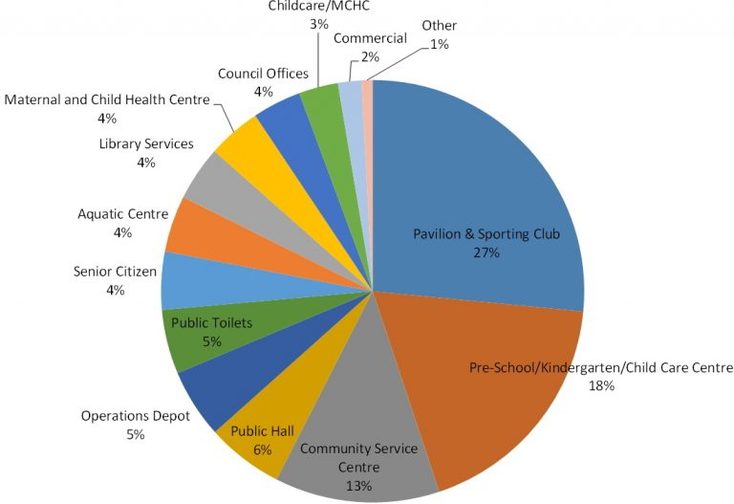Council Building Benchmarking
Assessing Building Performance
Council-owned buildings represent a substantial part of a local government authority’s base-line resource consumption, as well as an area were important savings can be achieved.
Therefore, understanding the performance profile of council-owned buildings represents an important area of accountability both from a cost-management perspective and a sustainability reporting perspective.
To help our members better understand the energy profile of their building stock, in 2015 the CVGA approached Ironbark Sustainability to help deliver a Council building Sustainability Benchmarking program. Five councils participating in the project, and submitted their 20 largest energy consuming buildings to be assessed. Participating councils included:
Breakdown of council building data by building type
Council-owned buildings represent a substantial part of a local government authority’s base-line resource consumption, as well as an area were important savings can be achieved.
Therefore, understanding the performance profile of council-owned buildings represents an important area of accountability both from a cost-management perspective and a sustainability reporting perspective.
To help our members better understand the energy profile of their building stock, in 2015 the CVGA approached Ironbark Sustainability to help deliver a Council building Sustainability Benchmarking program. Five councils participating in the project, and submitted their 20 largest energy consuming buildings to be assessed. Participating councils included:
- Buloke Shire Council
- Gannawarra Shire Council
- Macedon Shire Council
- Northern Grampians Shire Council
- Pyrenees Shire Council
Breakdown of council building data by building type
The approach adopted by the CVGA and Ironbark Sustainability has proven to be both highly cost effective and has provided relevant, and actionable results to feed into participating council’s capital works infrastructure and upgrades programs in future years. It has also resulted in highlighting gaps and areas where cost-effective improvements can be made in participating councils’ sustainability data collection and management processes (an increasingly important area of council operations, especially given the state government’s recent announcements regarding legislated GHG emissions targets and the “Take2” pledge process, see https://www.take2.vic.gov.au/).
The CVGA and Ironbark Sustainability are looking forward to expanding this project in future years: expanding the number of shires participating; the metrics analysed as well as; the support the Alliance can provide to its members in order to capitalise on the areas of building performance weakness this project has shown up.
The benchmarking process
The benchmarking process compared basic the sustainability attributes in these 20 buildings against similar buildings within that shire, buildings in other shires as well as against the 600+ buildings already on Ironbark’s database.
The metrics that were used to determine a building’s performance in relation to best practice included per m2 floor area consumption of the following:
Following the completion of the benchmarking project, Ironbark Sustainability contacted each council to talk though the results. The results are considered to provide good insights into building performance. The granularity of the results could be improved by adding the following metrics to the analysis:
Due to its relatively low-cost and demonstrable benefits, the CVGA and Ironbark Sustainability are actively exploring options for expanding the program across other shires, as well as exploring opportunities to undertake individual or aggregated sustainability actions to will lower resource consumption in council-owned buildings and costs to councils across the CVGA region.
The CVGA and Ironbark Sustainability are looking forward to expanding this project in future years: expanding the number of shires participating; the metrics analysed as well as; the support the Alliance can provide to its members in order to capitalise on the areas of building performance weakness this project has shown up.
The benchmarking process
The benchmarking process compared basic the sustainability attributes in these 20 buildings against similar buildings within that shire, buildings in other shires as well as against the 600+ buildings already on Ironbark’s database.
The metrics that were used to determine a building’s performance in relation to best practice included per m2 floor area consumption of the following:
- Electricity
- Gas
- Water
- Greenhouse gas emissions
Following the completion of the benchmarking project, Ironbark Sustainability contacted each council to talk though the results. The results are considered to provide good insights into building performance. The granularity of the results could be improved by adding the following metrics to the analysis:
- Hours of operation
- Building age
Due to its relatively low-cost and demonstrable benefits, the CVGA and Ironbark Sustainability are actively exploring options for expanding the program across other shires, as well as exploring opportunities to undertake individual or aggregated sustainability actions to will lower resource consumption in council-owned buildings and costs to councils across the CVGA region.
Download the full Benchmarking Report here… [Need report and link]


